Scroll to:
COST-DEPENDENT ELECTRIC CONSUMPTION AS A TOOL OF RISK MANAGEMENT OF NON-PAYMENT FOR ELECTRIC ENERGY OF INDUSTRIAL ENTERPRISES
https://doi.org/10.17747/2618-947X-2019-1-8-19
Abstract
The growth of indebtedness of industrial enterprises operating in conditions of economic instability for consumed electricity and the sanctions imposed by the energy supplying organizations for late payments, determine the urgency of the problem of managing the risks of non-payment for energy from industrial enterprises. The article is devoted to the description of the method developed by the authors for managing the risks of non-payment of industrial enterprises for consumed electricity, based on the principles of price-dependent electricity consumption. Based on the study of the mechanism of formation of the cost of electricity purchased by industrial enterprises in the wholesale and retail electricity markets, special methods were proposed to control each component of the cost of electricity: electrical energy, electrical power, electricity transmission services. It justifies the need to develop options for operating modes of industrial equipment, such as nominal load mode, load limiting mode, technological minimum load, in order to effectively implement and use price-dependent power consumption in crisis conditions.Modeling scenarios of price-dependent demand management for power consumption is made on the example of a machine-building enterprise and the calculation and component-wise analysis of the economic effect of price-dependent management and the factors influencing its formation are carried out. The developed method allows you to effectively manage the risks of non-payment of industrial enterprises for electricity, as well as minimize the risks of restricting the supply of electricity to industrial facilities and disruptions in the operation of industrial equipment.
Keywords
For citations:
Dzyuba A.P., Soloveva I.A. COST-DEPENDENT ELECTRIC CONSUMPTION AS A TOOL OF RISK MANAGEMENT OF NON-PAYMENT FOR ELECTRIC ENERGY OF INDUSTRIAL ENTERPRISES. Strategic decisions and risk management. 2019;10(1):8-19. https://doi.org/10.17747/2618-947X-2019-1-8-19
-
INTRODUCTION
Over the past decade, industrial enterprises in Russia were functioning in the conditions of continuous economic instability caused by the impact of the economic crisis, introduction of sanctions and increasing competition on international markets. The recent Federal Law On amendments to certain legislative acts of the Russian Federation on taxes and duties’ envisages the increase of the base rate of the value added tax from 18% to 20% from January 1, 2019.
The latter will lead to decreasing stability of operational activity of many industrial enterprises, which can cause delays in payments for raw material and consumed energy resources.
Electric power is the basic energy resource and is used in the primary and support production processes of the enterprise as well as for heating, water supply and lighting.
The practice of functioning of industrial enterprises in Russia in the crisis periods indicates that the available financial resources are primarily allocated to wages and purchase of materials and, as a residual, to payment for energy resources.
Fig.1. The share of expenditures on electric power in the product cost structure of Russia’s main industries
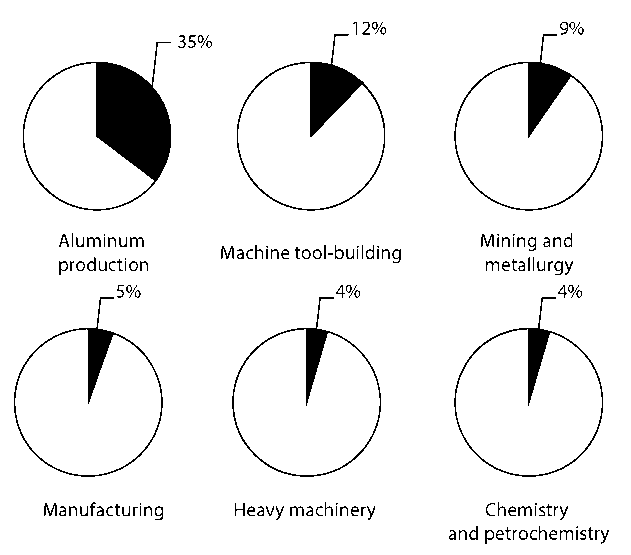
Table 1
Sanctions for non-payment for energy resources
|
Specifics related to non-payment for electric energy |
Retail electricity market |
Wholesale electricity market |
|---|---|---|
|
Normative acts regulating the procedure of payment for consumed electric power |
(Ordinance, 2012) |
(Annex No 16, 2019) |
|
Schedule of payment for consumed electric energy (power) |
• 30% of the cost of electricity till the 10th of the current month • 40% of cost of electricity till the 25th of the current month • the rest till the 18th of the next month after the billing one |
14th, 21st, 28th of the month. For various cost components: electric energy, electric power, transmission services, balancing market, dates are established within the mentioned periods |
|
Normative acts regulating penalties for non-payment for consumed electric energy |
(Federal Law, 2015) |
(Annex No 16, 2019) |
|
Penalty for non-payment for consumed electric energy |
• 1/130 of the refinancing rate for every day of the delay (or 21.7% per annum) |
• Bank guarantee issued by the authorized bank • sureties of the electric power suppliers on the wholesale market • security payment |
|
Sanctions for long-term non-payment for consumed electric energy |
• limiting the enterprise’s electricity consumption to the level of technological armour • terminating the energy supply contract with the enterprise |
• Elimination of a group of electricity supply points on the wholesale market • excluding from the regional membership of the electricity wholesale market |
|
Organizational implications in case of long-term non-payment for consumed electric energy |
• Absence of technological possibility of electricity consumption • consuming energy on the conditions applied in cases of non-contractual electricity consumption |
• Transfer to supply of electric energy from the regional guaranteeing energy supplier |
|
Economic implications for long term non-payment for consumed electric energy |
• Purchasing electric energy on considerably excessive tariffs |
• Purchasing electric energy on higher tariffs |
Over 1990-s, many industrial enterprises did not pay for energy resources (10 years of Federal Law FZ-35 ‘On electric energy’, [s.a.]; In OAO RAO UES, 2012), their debt to RAO UES exceeded 50% of the cost of supplied electric and thermal energy (Energy Workers, 1994). The situation improved slightly after the reform of electric energy industry and tightening of the payment discipline. Nevertheless, today a number of economic entities still have a considerable debt to energy suppliers. According to Russian Federation Federal Statistics Service, as at December 2017 consumers’ debt to energy suppliers was 821 bln Rubles. The population is responsible for only 20% of the indebtedness. For the most part, debtors are providers of housing and communal services and industrial enterprises.
-
RELEVANCE OFTHE PROBLEM
Among industrial enterprises, the most persistent debtors are the energy-intensive industries, which have a considerable share of electric energy in their product cost structure. Therefore, development of anti-crisis measures for management of payments for electricity is of great strategic significance for them. In machine tool-building, the share of the cost of electric power in the product cost structure is 12%, in mining and metallurgy - 9%, in manufacturing - 5% (Figure 1).
To tighten the payment discipline, the following measures are undertaken:
- tightening of the payment schedule;
- increasing penalties for late payments;
- limiting electricity supply in case of late payments (Ordinance, 2012; Federal Law, 2015);
- introducing sanctions for non-payment on the legislative level (Table I).
Non-payment for electric power leads to considerable risks of electric power cost rising and risks that its supply to the enterprise can be limited, risks of production stopping, failure to implement the product output plan, failure to fulfill commitments before the customers.
The sector-specific peculiarities of majority industrial enterprises functioning require them to maintain some of the technological processes even if products are not manufactured: heating and ventilation, hot and cold water supply, wastewater disposal, lighting and alarms. Some of the enterprises are under obligation to supply energy resources generated by them to the population connected to their power grid. Steelmaking, chemical and petrochemical production, some kinds of manufacturing industries do not envisage halting the production process; otherwise it takes a lot of time to relaunch the production and/or change the essential equipment.
Experiencing the conditions of financial instability and having substantial debts to energy supplying organizations, some enterprises, mainly machine-building, resort to extreme measures: reduce the number of working shifts, temporarily withdraw energy-intensive equipment from service in order to reduce the debt burden by reducing the energy consumption.
Considering the mentioned economic and technological specifics, the majority of industrial enterprises require sustainable operation of primary and support equipment even in the conditions of economic crisis. The need to manage the risks of non-payment for electric energy is evident for ensuring operation of industrial enterprises in the conditions of economic instability, in particular, at the expense of reducing relevant expenditures.
In view of the foregoing, we have developed recommendations on reducing the costs of electricity for industrial enterprises in the condition of economic instability. To manage the risks of nonpayment, it is expedient to use a mechanism of price-dependent electricity consumption: consumers manage their own demand schedule on the basis of price signals of the energy market with a view to reduce expenditures on electricity (Dzyuba, Solovieva, 2017). This is one of the elements of the electricity consumption demand managing system (Volkova, 2016; Gitelman, Ratnikov, Kozhevnikov et al., (2013). Solovieva, Dzyuba, 2017b). To elaborate recommended measures on price-dependent electricity consumption management, it is necessary to conduct an analysis of mechanisms of forming the expenditures on every component of electricity cost.
Fig. 2 Structure of electric energy cost (Ordinance, 2010)
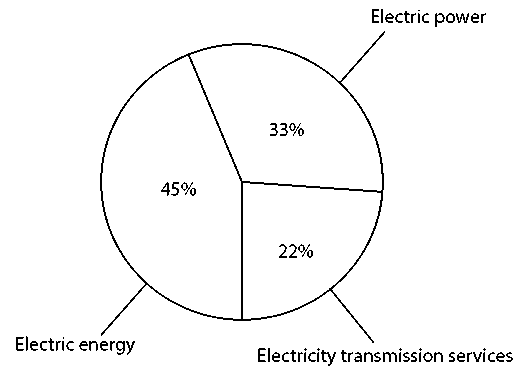
-
METHODOLOGY OF THE STUDY
The cost of electric energy purchased by the industrial enterprises at the wholesale and retail markets consists of three main components (Fig. 2):

where Se is the cost of electric energy in Rubles; Sp - cost of electric power in Rubles; St - cost of electricity transmission services in Rubles.
-
'COST OF ELECTRIC ENERGY’ COMPONENT
The cost of electric energy reflects the unit costs of the energy system to generate electricity in every hour of the day. The calculation of the amount of obligation to pay for electric energy is defined as a product of prices for electric energy differentiated by hours of the calculation period and individual amount of hourly electricity consumption of specific consumer.

where Wt is electric energy consumed by an industrial enterprise from an energy system in hour /, kWh; CJ - price for electric energy differentiated by hours of the calculation period in relation to the volume of electric energy supplied in an hour of the calculation period, Rubles/kWh. For the participants of the wholesale market - hourly market price for the day ahead, for the participants of the retail market - non-regulated price for electric energy differentiated by hours of the calculation period, for the territories of the East Integrated Power System - regulated price for electric energy differentiated by hours of the calculation period.
Figure 3. Hourly prices for electric energy at the wholesale market of the Leningrad region, July 17-23, 2017 (Administrator, [s.a.])
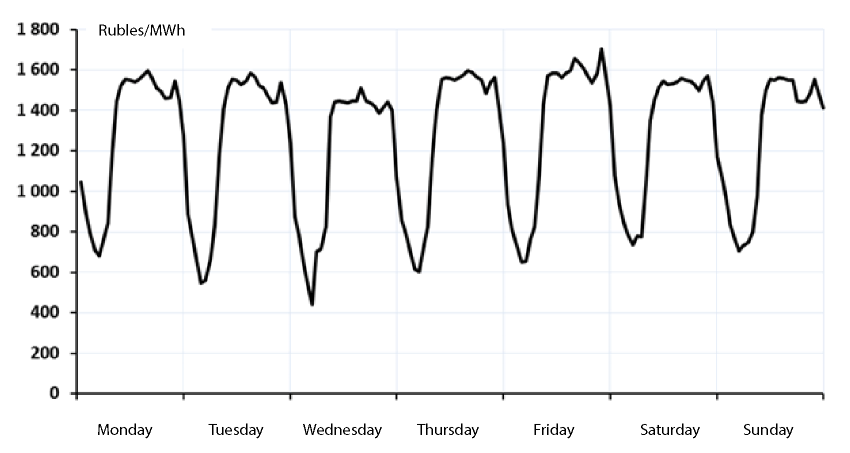
The example of hourly energy prices at the wholesale energy market ofthe Leningrad region from 17thto23rdof July 2017 (fig. 3) demonstrates a considerable diurnal volatility and a significant spread between the prices at time of the night minimum load and at the hours of daily maximum of the power system.
In a period of economic crisis, price-dependent management of electricity costs should lie in the redistribution of volumes of electricity consumption to the time when it is economically beneficial. Then, industrial enterprises will save up to 70% of the costs of this component or up to 30% of the total costs of electric energy. When developing options to optimize the electric load schedule, it is necessary to take into account technological parameters of production and energy market parameters. It is worthwhile to identify the range of price-dependent management of electric load hourly schedule basing on projected hourly prices for electric energy. The methodology for projecting prices for electric energy suggested by us is described in other papers in more details (Solovieva, Dzyuba, 2013; Solovieva, Dzyuba, 2017a).
-
'COST OF ELECTRIC POWER’ COMPONENT
Cost of electric power reflects the payment for the readiness of the energy system to generate electricity in the needed volume in a certain period of consumption. The obligation to pay for electric power is calculated as a mean value of the power consumed by an enterprise in the hours coinciding with the hours of the daily maximum of electricity consumption of the regional rwhere F m is the obligation for purchasing power by an industrial enterprise in the month m\ C - the price of power purchased by an industrial enterprise in the month m\ t - hour of the daily maximum of electricity consumption of the regional power system over the working days of the billing month (Annex 13.2,2019).

гwhere Vp.m is the obligation for purchasing power by an industrial enterprise in the month m; Cp.m – the price of power purchased by an industrial enterprise in the month m; t max.р – hour of the combined peak demand for a federal entity where the enterprise is buying energy in the hour t of the working day in the month m; nwd.m – number of the working days in the month m; Tp – intervals of peak load planned hours approved by the System Operator of the Unified Energy System of Russia.
Figure 4 shows the intervals of the planned peak load hours approved by the System Operator of the Unified Energy System of Russia for the first price zone of the wholesale market for 2018, Figure 5 - the hours of the combined maximum demand of the Leningrad region power system over the working days in 2016.
Price-dependent management of electricity costs in the period of economic crisis, in our view, should lie in shifting of electricity consumption from the regional power system peak time, which can enable the industrial enterprises to reduce costs of electric energy up to 33% comparing with the initial costs. The range of price-dependent management of electric load hourly schedule is appropriate to identify basing on the projected peak time of the power system; respective proprietary methodology is described in other papers in more details (Dzyuba, 2014; Solovieva, Dzyuba, 2014).
Fig. 4. Planned peak load hours for the first price zone of the wholesale market for 2018 (Planned hours, 2017)
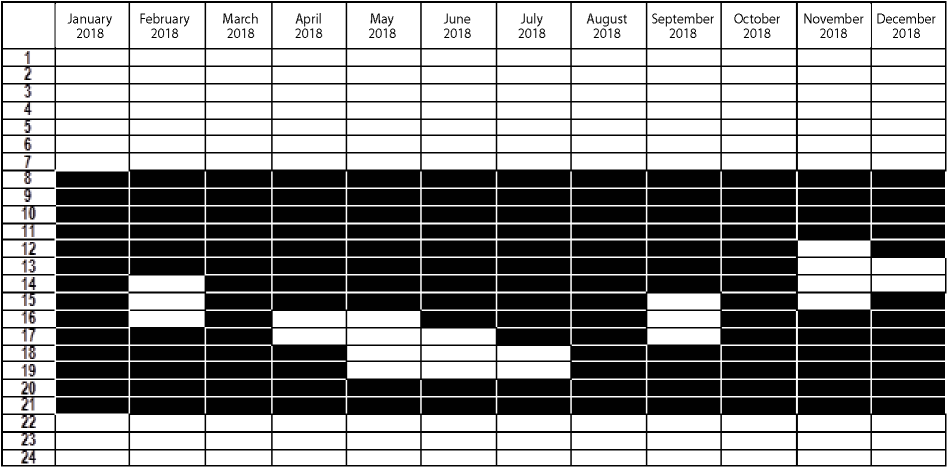
-
'ELECTRICITY TRANSMISSION SERVICES COST’ COMPONENT
The cost of electricity transmission services reflects the payment for the use of the electricity grid infrastructure for the transportation of electric energy generated by the power plants to the end users. Consumers can use price-dependent management of electricity costs only if they use a two-part tariff to pay for energy. The electricity transmission services cost is calculated according to the formula (Ordinance, 2012):

where  is the cost of electricity transmission services according to a two-rate tariff taking into account the cost of electricity grid maintenance in the month m, kW / month.;
is the cost of electricity transmission services according to a two-rate tariff taking into account the cost of electricity grid maintenance in the month m, kW / month.;  – the cost of electricity transmission services according to a two- rate tariff taking into account the technology costs (losses) in the electricity grid in the month m, kWh.
– the cost of electricity transmission services according to a two- rate tariff taking into account the technology costs (losses) in the electricity grid in the month m, kWh.

where  is the tariff rate for electricity grid maintenance in the month m;
is the tariff rate for electricity grid maintenance in the month m;  – is the value assumed for the calculation of the payment obligations for electricity grid maintenance in the month m.
– is the value assumed for the calculation of the payment obligations for electricity grid maintenance in the month m.

where max (WtTp) is the maximum value of energy consumption in the period of intervals of planned peak load hours Tp approved by the System Operator of the Unified Energy System of Russia, for a working day of the month.
Fig. 5. The hours of the combined peak demand of the energy system of Leningrad region over the working days in 2016 (Administrator, [s.a.])
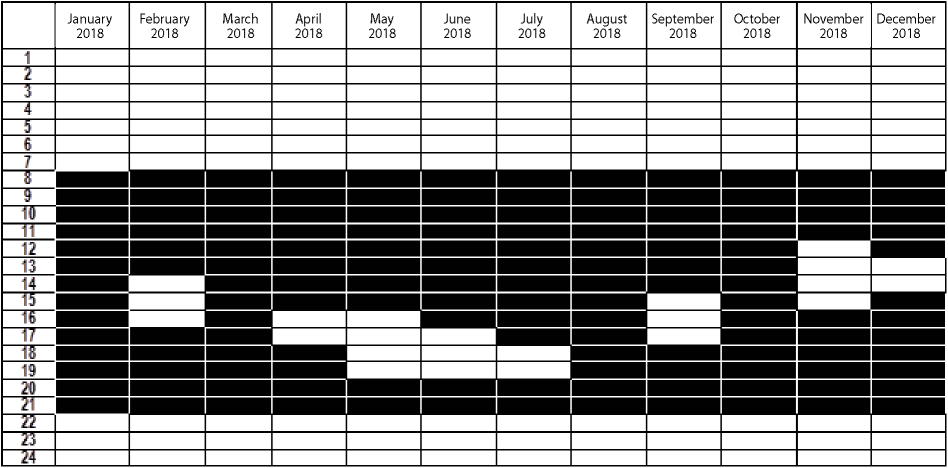
Fig. 6. Structure of electric energy tariff for industrial enterprises by voltage levels
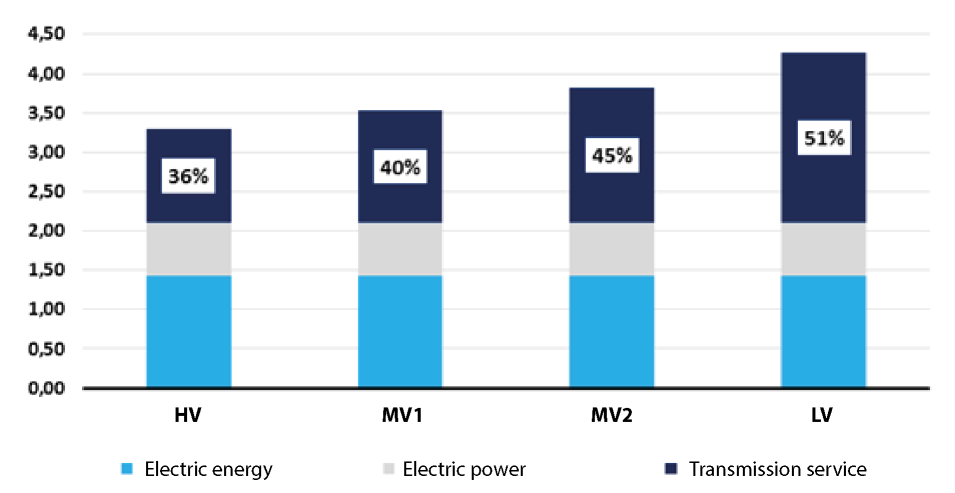

where Tmt.c- is the tariff rate to pay for the technology costs (losses) in the electricity grid in the month m.
For all the regions of Russia, the cost of electricity transmission services is differentiated by levels of powering voltage: FlV (high voltage, 110 kV and higher), MVl (first medium voltage, 35 kV), MV2 (second medium voltage, 20-1 kV), LV (low voltage, 0.4 kV and lower) (Order, 2004). The lower voltage level, the higher is the electricity transmission services tariff. Consequently, for the FlV level the percentage of costs for electricity transmission services is 36%, and for the LV level — 51 % (Fig. 6).
The results of the analysis of cost formation mechanism for every component of electric energy expenditure are presented in the Table 2. It is evident that the cost of every component depends on the hourly schedule of electricity consumption of a specific enterprise Wf which is mathematically described by a respective system of equations.

Table 2
Mechanism of forming energy cost components
|
Cost component |
Cost forming principle |
Period of forming |
Направление снижения затрат |
|---|---|---|---|
|
Electric energy |
Energy consumption in the period of power system maximum demand |
Period of power system peak load |
Reducing electricity consumption in the period of power system maximum demand |
|
Electric power |
Energy consumption in the hour of daily power system maximum demand |
Hour of the daily maximum demand of the regional power system |
Reducing electricity consumption in the hour of daily maximum demand of the power system |
|
Energy transmission services |
Irregular energy consumption in the period of the peak load hours |
Period of power system peak load |
Reducing electricity consumption in the planned peak load hours |
-
PRACTICAL IMPLEMENTATION
The structure of energy consumption of any industrial enterprise is described by the electricity consumption graphs of separate production and support facilities, i.e. workshops, buildings, furnaces, mills, etc. As a rule, the bulk of the energy demand is concentrated on separate units of energy-intensive facilities, which are part of the unified production process or a value chain. The energy demand of separate energy-intensive entities forms the group (combined) graph of energy demand of an industrial enterprise (Fig. 7).
Table 3
Options of operating schedules of equipment at an industrial enterprise
|
Operating schedule of an enterprise |
Description of the equipment operation |
Equipment load in the periods of planned peak load hours of the power system |
|---|---|---|
|
Nominal load mode |
The schedule of production equipment in base load for plan execution |
80-100% depending on specific production plans and the work of related production lines |
|
Load limitation mode |
The schedule of production equipment in load limitation mode for plan execution |
25-80% |
|
Minimum safe output |
The schedule of production equipment in a mode to maintain viability of enterprise engineering systems without product output |
0-25% depending on technological features of production |
Price-dependent management of electricity costs is carried out by way of managing configuration of the work of separate energy- intensive production facilities that have impact on the amount of obligations to pay for the electric energy costs components of the industrial enterprise. The size and range of adjustments are determined by specific economic conditions (Table 3).
With a view to reduce the electricity costs, regulation of electric load schedules can be carried out within a relatively short control range, at around ±20% of the nominal electricity consumption load (Baev, Solovieva, Dziuba, 2017); if there are risks connected with limiting of power supply to the enterprise and shutdown of primary production equipment, price-dependent load regulation is admissible within a wider range, up to reducing power consumption of some production facilities to 100% of the nominal load.
In a crisis period, the model of price-dependent management of electricity costs at industrial enterprises has many constraints: the internal ones include technological and organizational possibilities to shift the work schedule of production equipment, external ones - established deadlines to fulfill the output plans, economic possibilities of the environment to use hourly electricity tariffs to reduce the electricity consumption costs within the required range.
Fig. 7. Example of forming a group combined electric load graph for industrial enterprises
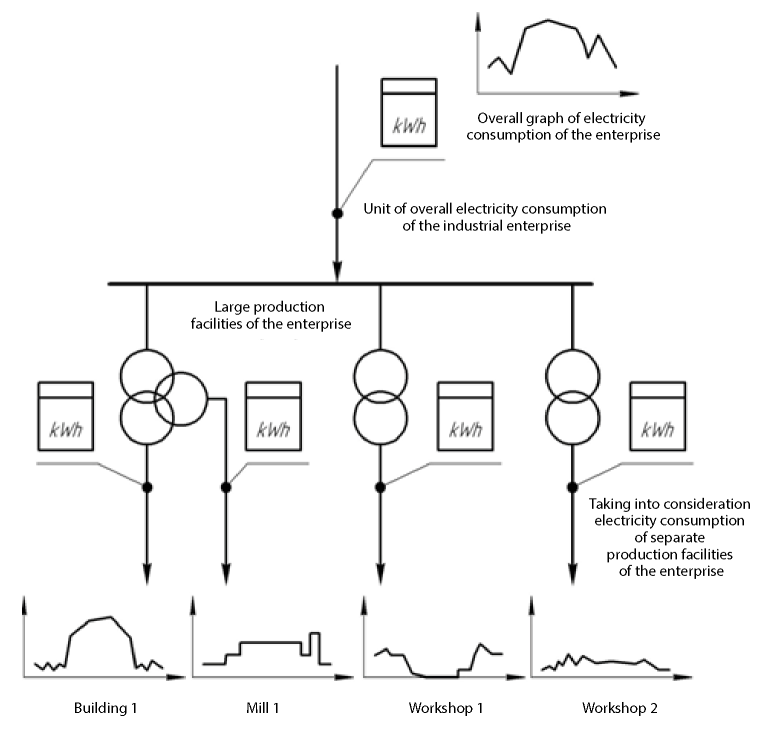
Fig. 8. Hourly graph of the nominal load mode of the work of equipment of the industrial enterprise in April 2017
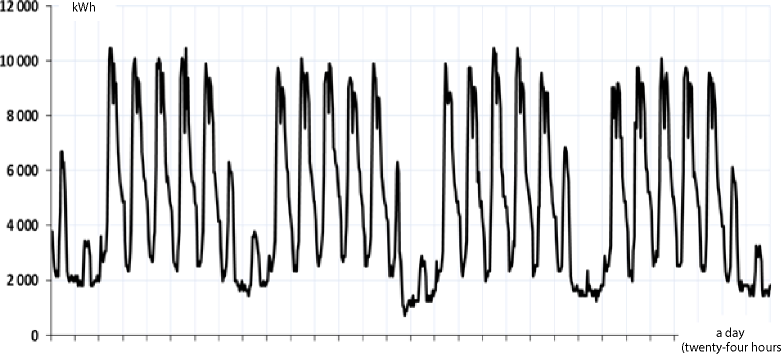
Fig. 9. Changing the parameters of hourly graphs of electricity consumption of an industrial enterprise from the nominal load mode to the load limitation mode and to minimum safe output on the example of a working week
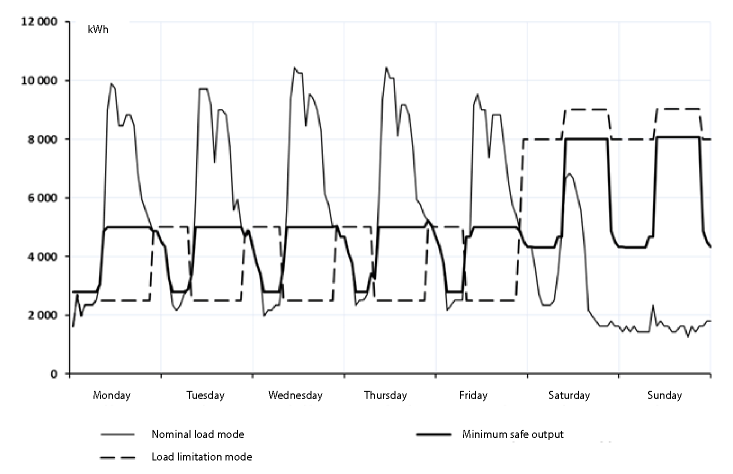
With regard to price-dependent management of energy consumption, industrial enterprises should consider a number of factors:
- ensuring economic efficiency of shifting primary and support production personnel to the second shift and overnight regime, working on weekends and holidays;
- compliance with the conditions of technological viability of production equipment exploitation when the work load is reduced to load limitation mode and to minimum safe output;
- consideration of parameters of technological processes in one production chain with the equipment, through which the price-dependent management is carried out;
- consideration of logistical processes and stock when changing the work schedule of technological processes;
- implementing a system of operational accounting and control of parameters of energy demand, parameters of calculating the economic effect of price-dependent management of electricity costs;
- harmonization of the system of accounting and modelling of the processes of price-dependent management of electricity consumption and production process control system;
- ensuring the possibility of flexible management of production processes schedule in order to promptly correct the parameters of price-dependent electricity consumption management;
- consideration of parameters of increasing cost of purchasing other energy resources (for example, natural gas) in case of redistribution of the production equipment work schedules.
Table 4
Economic indicators of various options of price-dependent management of electricity consumption
|
Indicator |
Nominal load mode |
Load limitation mode |
Minimum safe output |
Comparison of the nominal and limitation modes, % |
Comparison of the minimum safe output and the nominal modes, % |
|---|---|---|---|---|---|
|
Montlily volume of consumption, kWh |
3465 180 |
3465 180 |
3465 180 |
0 |
0 |
|
Cost of electric energy, Rubles |
23004 359 |
13521 132 |
8510 482 |
59 |
37 |
|
Energy tariff, Rubles/kWh, including: |
6.639 |
3.902 |
2.456 |
59 |
37 |
|
payment obligation for electric power, MWt/month |
9.2116 |
5.0000 |
2.5000 |
54 |
27 |
|
payment obligations, MWt/month |
9.9090 |
5.0000 |
2.5000 |
50 |
25 |
|
average price for component ‘electric energy’, Rubles/kWh |
1.173 |
1.140 |
1.090 |
97 |
93 |
-
CALCULATION EXAMPLE
The example selected is a machine-building enterprise in crisis conditions, purchasing electricity on the territory of Leningrad region. The graph of hourly electricity consumption in the nominal load mode of the equipment’s work over a calendar month (April 2017) (Fig. 8) is distinguished by cyclic volatility, increasing load in the daytime and decreasing - during the night shifts, which is typical for facilities with a single shift.
The enterprise has accumulated considerable debts for electricity. To exclude the risk of technological limitation of energy supply and to keep the production output level, the management of the enterprise decides to shift the processes to the time when the power system consumes minimum energy. Figure 9 shows two options of a modelled electricity demand schedule in the load limitation mode and in minimum safe output mode.
The graph ‘nominal load mode’ corresponds to the hourly schedule of electricity consumption in the nominal load mode. In the hours of power system peak load, the power of over 10 MWt is consumed, in the period of power system minimum demand at night it drops to 2 MWt. On weekends, a considerable decrease in electricity consumption is also observed, and it is lower than the power system minimum demand at night on week days.
The graph Toad limitation mode’ is characterized by a decrease of power consumption by the enterprise in the intervals of the hours of power system peak load from the medium level of 10 MWt to 5 MWt. The difference, by which the load had to be reduced, was redistributed to night working hours and weekends. Total monthly volume of electricity consumption of the enterprise remained unchanged.
The graph ‘minimum safe output’ implies a decrease of power consumption in the intervals of the hours of power system peak load from the medium level of 10 MWt to 2.5 MWt. The difference, by which the load had to be reduced, was redistributed to weekends and night working hours. Total monthly volume of electricity consumption of the enterprise remained unchanged.
The results of calculation of expenditures on electricity for the modelled options of load graphs are presented in Table 4. In three options, the total monthly volume of power consumption is equal and amounts to 3 465 180 kWh. For the ‘nominal load mode’ option, the obligation to pay for electric power is 9.2116 MWt/month, obligation to pay for electricity transmission services is 9.9090 MWt/month. For the Toad limitation mode’ and the ‘minimum safe output’ options, the component of payment obligation for electric power decreased by 46 and 73% respectively, the component of payment obligation for electricity transmission services decreased by 50 and 75% respectively. Meanwhile, the average cost of purchasing the component ‘electric energy’ went down just by 3 and 7% respectively since the electric load was redistributed to peak periods of weekends as well, which led to buying electric energy for peak prices of the weekends.
The decrease of the mentioned components led to reducing both overall costs of electricity consumption and tariffs to purchase electric energy for the enterprise: in the Toad limitation mode’ option - by 41%, in the ‘minimum safe output’ option - by 63%, or by 9 483 227 and 14 493 877 Rubles respectively.
After shifting to the load limitation mode or minimum safe output mode, the enterprise has an opportunity to reduce the debt for the previous period, settling it at the expense of funds saved, or reduce the risks of non-payment for power in the future. Furthermore, reduction of expenditures on electricity while keeping the same output levels will enable the enterprise to raise the financial stability indicators and sooner overcome crisis situation.
The ultimate economic effect of price-dependent management of load graphs should be calculated considering the change of shifts, increase in costs of lighting during night and evening shifts. However, if the expenditures of the enterprise on electricity are large, the suggested organizational measures, in the majority of cases, will be economically viable.
-
CONCLUSION
In crisis periods, enterprises that need to maintain production and support processes face the risks of non-payment to energy supplying companies. The legislation of the Russian Federation in force related to electricity envisages severe sanctions against industrial enterprises for violating payment discipline, which determines the need to manage the risks of non-payment for electricity during a crisis.
The analysis of mechanisms of forming the cost of electricity purchased by industrial enterprises at wholesale and retail energy markets indicated that the enterprises on their own can manage all the components of the cost of purchased electric energy: the cost of electric energy, the cost of electric power and the cost of transmission services. Management of expenditures on every cost component is carried out by varying their own hourly electricity demand schedule with due regard for parameters formed by the wholesale market regulators and by mechanisms of flexible formation of hourly prices for electricity supply.
The suggested classification of load modes determines the possibilities to apply the tools of price-dependent management of electricity consumption in various economic conditions of the activity of enterprises. The management of electricity demand schedules in a crisis period differs from management in basic operation period by the depth of regulating such schedules. We have suggested the ranges of price-dependent management of load graphs to the levels Toad limitation mode’ and ‘minimum safe output mode’, which enables the enterprises to considerably reduce the expenditures for purchased electricity and the nonpayment risks in the future.
Using the example of electricity consumption of a machine- building enterprise that buys electricity on the territory of Leningrad region, by modelling the options of price-dependent management of electricity consumption load schedules, we showed the possibility to reduce the obligations to pay for electricity costs while maintaining the same total monthly volume of electricity consumption. In the load limitation mode, obligations to pay for electricity were reduced by 41%, in the minimum safe output mode - by 63%, which underscores the effectiveness of the suggested method.
The systematization of factors impacting the effectiveness of price-dependent management of electricity consumption in a crisis enables us to assess more precisely the appropriateness and efficiency of the measures taken and avoid inaccuracies and mistakes in the management process.
The developed method of price-dependent management of electricity consumption allows to efficiently manage the risks of non-payment for electricity by industrial enterprises in a crisis; minimize the risks of forming a debt to energy suppliers and of limited electricity supply to production facilities; to increase overall economic indicators of the enterprise.
SPONSORSHIP
The article has been prepared with the support of the Government of the Russian Federation (Ordinance No 211 of March 16, 2013), agreement No 02.A03.21.0011.
References
1. Administrator torgovoj sistemy optovogo rynka ([b. g.]). [Administrator of the wholesale market trading system ([s.a.]). (In Russ.).]. http://www.atsenergo.ru.
2. V RAO «EEHS Rossii» obespokoeny narastayushchimi neplatezhami za potreblennuyu ehlektricheskuyu i teplovuyu ehnergiyu na Dalnem Vostoke (2012) // Energetika i promyshlennost Rossii. 27 noyab. [RAO UES of Russia is concerned about the increasing non-payment for the consumed electric and thermal energy in the Far East (2012). Energy and Industry of Russia. Nov. 27. (In Russ.).] URL: https://www.eprussia.ru / news / base / 2002 / 2359.htm.
3. Volkova, I. O. (2016). Intellektualnaya ehnergetika v Rossii: ocenka sushchestvuyushchego potenciala razvitiya // Ekonomika i organizaciya promyshlennogo proizvodstva. 12:90–101. [Volkova, I. O. (2016). Intellectual power engineering in Russia: assessment of the existing development potential. Economy and Organization of Industrial Production. 12: 90–101. (In Russ).]
4. Gitelman, L. D., Ratnikov, B. E., Kozhevnikov, M. V. i dr. (2013). Upravlenie sprosom na ehnergiyu Unikalnaya innovaciya dlya rossijskoj ehlektroehnergetiki Ekaterinburg EHkonomika, 120 s. [Gitelman, L. D., Ratnikov, B. E., Kozhevnikov, M. V. et al. (2013). Managing Energy Demand. A unique innovation for the Russian electric power industry. Ekaterinburg: Economy. 120 p. (In Russ.).]
5. 10 let FZ-35 «Ob elektroenergetike» // Sovet rynka. [10 years of the Federal Law-35 «On electric power industry» ([s.a.]). Market Council. (In Russ.).]. http://www.en.np-sr.ru / en / press / news / 10 let-fz-35 ob-elektroenergetike-aleksandra-panina-blagodarya-prinyatomu-zakonu-byli-sozdany-usloviya-dlya-razvitiya-konkurentnogo-rynka-elektroenergii.
6. Dzyuba, A. P. (2014). Povyshenie ehnergeticheskoj ehffektivnosti promyshlennogo ehlektropotrebleniya posredstvom upravleniya zatratami na pokupku elektricheskoj moshchnosti. In: Energosberezhenie informacionnye tekhnologii i ustojchivoe razvitie. Mezhdunar nauch. prakt. internet-konf. Izhevsk IzhGTU im. M. T. Kalashnikova. S. 35–42. [Dzyuba, A. P. (2014). Increasing the energy efficiency of industrial electricity consumption by managing the cost of purchasing electric power. In: Energy Saving, Information Technologies and Sustainable Development: Intern. scientific-practical internet conf. Izhevsk: IzhSTU them. M. T. Kalashnikov. 35–42. (In Russ.).].
7. Dzyuba, A. P., Soloveva, I. A. (2017). Cenozavisimoe upravlenie elektropotrebleniem i energozatratami na proizvodstvennykh objektakh metallurgicheskogo kompleksa // Metallurg. 1:8–15 [Dzyuba, A. P., Solov'eva, I. A. (2017). Price-dependent control of power consumption and energy consumption at industrial facilities of the metallurgical complex. Metallurg. 1:8–15. (In Russ.).].
8. Planovye chasy pikovoj nagruzki na 2018 god dlya territorij otnesennykh k cenovym zonam optovogo rynka elektricheskoj energii i moshchnosti i territorij otnesennykh k necenovym zonam optovogo rynka elektricheskoj energii i moshchnosti ot 21.12.2017 g. (2017) // Sistemnyj operator Edinoj ehnergeticheskoj sistemy. [Planned peak load hours for 2018 for territories assigned to the price zones of the wholesale electricity and capacity market, and territories assigned to non-price zones of the wholesale electricity and capacity market from 21.12.2017 (2017). System Operator of the Unified Energy System. (In Russ.).]. http://so-ups.ru / index.php id=newonsite_view&no_cache=1&tx_ttnews [ [_t_news_=12010.
9. Postanovlenie Pravitelstva RF ot 04.05.2012 № 442 «O funkcionirovanii roznichnykh rynkov elektricheskoj energii polnom i ili chastichnom ogranichenii rezhima potrebleniya elektricheskoj energii // KonsultantPlyus. [Decree of the Government of the Russian Federation of 04.05.2012 № 442 «On the functioning of retail electricity markets, full and (or) partial restriction of the mode of consumption of electrical energy». ConsultantPlus. (In Russ.).]. http://www.consultant.ru / document / cons_doc_LAW_130498 / .
10. Postanovlenie Pravitelstva RF ot 27.12.2010 № 1172 «Ob utverzhdenii Pravil optovogo rynka elektricheskoj energii i moshchnosti» // KonsultantPlyus. [Decree of the Government of the Russian Federation dated December 27, 2010 № 1172 «On approval of the Rules of the wholesale market of electric energy and power». ConsultantPlus. (In Russ.).]. http://www.consultant.ru / document / cons_doc_LAW_112537 / .
11. Prikaz FST Rossii ot 06.08.2004 № 20 eh / 2 Ob utverzhdenii Metodicheskikh ukazanij po raschetu reguliruemykh tarifov i cen na ehlektricheskuyu teplovuyu ehnergiyu na roznichnom potrebitelskom rynke // KonsultantPlyus. [Order of the Federal Tariff Service of Russia of August 6, 2004 No. 20 e / 2 «On Approval of Guidelines for the Calculation of Regulated Tariffs and Prices for Electric (Thermal) Energy in the Retail (Consumer) Market». ConsultantPlus. (In Russ.).]. http://www.consultant.ru / document / cons_doc_LAW_50075 / .
12. Prilozhenie № 13–2 k dogovoru o prisoedinenii k torgovoj sisteme optovogo rynka ehlektroehnergii Reglament opredeleniya obemov pokupki i prodazhi moshchnosti na optovom rynke (2019) // Sovet rynka. [Appendix No. 13.2 to the agreement on accession to the trading system of the wholesale electricity market «Regulations for determining the volume of purchase and sale of capacity in the wholesale market» (2019). Market Council. (In Russ.).]. https://www.np-sr.ru / ru / regulation / joining / reglaments / 1978. (In Russ).].
13. Prilozhenie № 6 k dogovoru o prisoedinenii k torgovoj sisteme optovogo rynka ehlektroehnergii Reglament finansovykh raschetov na optovom rynke ehlektroehnergii (2019) // Sovet rynka. [Appendix No. 16 to the agreement on accession to the trading system of the wholesale electricity market «Financial Settlement Regulations on the Wholesale Electricity Market» (2019). Market Council. (In Russ.).]. https://www.np-sr.ru / ru / regulation / joining / reglaments / 2013.
14. Prilozhenie № 26 k dogovoru o prisoedinenii k torgovoj sisteme optovogo rynka ehlektroehnergii Polozhenie o poryadke predostavleniya finansovykh garantij na optovom rynke 2019 // Sovet rynka (2019). [Appendix №26 to the agreement on accession to the trading system of the wholesale electricity market «Regulations on the procedure for providing financial guarantees on the wholesale market» (2019). Market Council. (In Russ).]. https://www.np-sr.ru / ru / regulation / joining / reglaments / 2015.
15. Soloveva, I. A., Dzyuba, A. P. (2013). Prognozirovanie ehlektropotrebleniya v promyshlennykh kompleksakh i regionakh, pod obshch. red. prof. I. A. Baeva. M.: Nauka Inform Voronezh VGPU. 153 s. [Solovyova, I. A., Dzyuba, A. P. (2013). Forecasting of power consumption in industrial complexes and regions, ed. prof. I. A. Bayeva. M.: Science: Inform; Voronezh: VGPU. 153 p. (In Russ.).].
16. Soloveva, I. A., Dzyuba, A. P. (2014). Strategiya upravleniya zatratami na ehlektropotreblenie promyshlennogo predpriyatiya // IV Mezhdunarodnaya nauchno-prakticheskaya konferenciya Problemy obespecheniya bezopasnogo razvitiya sovremennogo obshchestva Uralskij federalnyj universitet imeni pervogo Prezidenta Rossii B. N. Elcina, Institut ehkonomiki Uralskogo otdeleniya RAN. Ekaterinburg: OOO Izdatelstvo UMC UPI. 47–57. [Solovyova, I. A., Dzyuba, A. P. (2014). The strategy of managing the cost of electricity consumption of an industrial enterprise. In: IV International Scientific and Practical Conference «Problems of ensuring the safe development of modern society» / Ural Federal University named after the first President of Russia B. N. Yeltsin, Institute of Economics, Ural Branch of the Russian Academy of Sciences. Ekaterinburg: Publishing House UMT UPI. 47–57. (In Russ.).].
17. Soloveva, I. A., Dzyuba, A. P. (2017a). Upravlenie zatratami na ehlektropotreblenie promyshlennykh predpriyatij na baze modeli optimizacii grafikov ehlektricheskikh nagruzok Izvestiya Tulskogo gosudarstvennogo universiteta. Ekonomicheskie i yuridicheskie nauki. 1–1:165–174. [Solovyova, I. A., Dzyuba, A. P. (2017a). Managing the costs of electricity consumption of industrial enterprises based on the model of optimizing the graphs of electrical loads // News of Tula State University. Economic and legal sciences. 1–1:165–174. (In Russ.).].
18. Soloveva, I. A., Dzyuba, A. P. (2017b). Upravlenie sprosom na ehlektroehnergiyu v Rossii sostoyanie i perspektivy. //Vestnik Samarskogo gosudarstvennogo ehkonomicheskogo universiteta. 3(149):53–62. [Solov'eva, I. A., Dzyuba, A. P. (2017b). Managing Electricity Demand in Russia: Status and Prospects. Bulletin of the Samara State University of Economics. 3(149):53–62.
19. Federalnyj zakon «O vnesenii izmenenij v otdelnye zakonodatelnye akty Rossijskoj Federacii v svyazi s ukrepleniem platezhnoj discipliny potrebitelej ehnergeticheskikh resursov» ot 03.11.2015. № 307 FZ // ConsultantPlus. [Federal Law «On Amendments to Certain Legislative Acts of the Russian Federation in Connection with Strengthening the Payment Discipline of Consumers of Energy Resources». 03.11.2015. N 307 FZ. ConsultantPlus. (In Russ.).]. http://www.consultant.ru / document / cons_doc_LAW_188331 / .
20. Energetiki gotovyatsya k zime (1994). Kommersant. 16 avg. 152 [Power engineers prepare for winter (1994). Kommersant. Aug 16. 152. (In Russ.).] https://www.kommersant.ru / doc / 86894.
21. Baev, I. A., Solovieva, I. A., Dziuba, A. P. (2017). Assessment and analysis of the infrastructural potential of Russian regions. In: 3rd International Conference on Industrial Engineering. SHS Web Conf. Vol. 35.
About the Authors
A. P. DzyubaRussian Federation
PhD in Economics, Department of Finance, Money Circulation and Credit, Higher School of Economics and Management, South Ural State University (National Research University). Research interests: energy management of industrial enterprises, demand management, price-dependent power consumption.
I, A. Soloveva
Russian Federation
Doctor of Economic Sciences, Associate Professor, Department of Finance, Money Circulation and Credit, Higher School of Economics and Management, South Ural State University (National Research University). Research interests: energy management of industrial enterprises, price-dependent power consumption, investment analysis and investment risk assessment.
Review
For citations:
Dzyuba A.P., Soloveva I.A. COST-DEPENDENT ELECTRIC CONSUMPTION AS A TOOL OF RISK MANAGEMENT OF NON-PAYMENT FOR ELECTRIC ENERGY OF INDUSTRIAL ENTERPRISES. Strategic decisions and risk management. 2019;10(1):8-19. https://doi.org/10.17747/2618-947X-2019-1-8-19









































